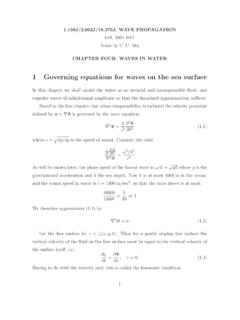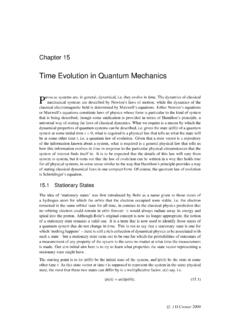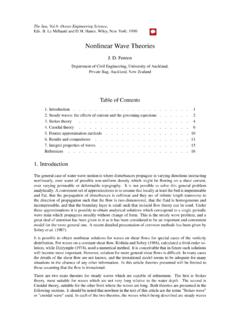Transcription of CHAPTER 5 - SYMMETRY AND VIBRATIONAL …
1 CHAPTER 5 - SYMMETRY AND VIBRATIONAL Potential Energy DiagramsThe energy of a molecule can be approximated as E = Erot + Evib + Eelec + Etran + Espin +Enucl. If we make the approximation that the wavefunction is separable, then the problem can bereduced to several smaller tasks. This amounts to the assumption of the Born-Oppenheimerapproximation, which permits the nuclear and electronic motions to be analyzed separately. In fact,this approximation breaks down, and leads to the Jahn-Teller phenomenon and other vibroniceffects. Let us now address the pure VIBRATIONAL problem. Exchange of energy between a moleculeand the electromagnetic field occurs when hn = E, where E is the difference between initial andfinal quantized states.
2 In terms of energiesn=clcm/seccmHz=n_ncm-11l===cInfr ared absorption spectra usually cover the range 200-4000 cm-1 or micrometers(microns). The conversion factor 1 = 8066 cm-1 or 23 kcal/mole is also useful to energies are about 200 cm-1 at room temperature and rotational energies are 1-100cm-1. Most infrared spectrometers provide the spectrum in the form of % transmittance Transmittance spectra tend to emphasize weak absorptions in the spectrum. Spectra ofthe same sample recorded at different concentrations will have different relative peak heights, whendisplayed as % transmittance. Conversion to absorbance spectra (absorbance = -log10(transmittance) is an option available on most spectrometers.)
3 Absorbance spectra should be usedwhenever peak ratios or concentration information is desired ( , in kinetics, where the decrease orincrease of concentration must be monitored). The other important aspect to IR and Ramanspectroscopy is that the time scale of the measurement amounts to the time it takes for a vibration (~ psec). Even rapidly isomerizing species show distinct VIBRATIONAL spectra in contrast to slowertechniques, such as NMR shows the VIBRATIONAL potential energy surface for a harmonic oscillator (A)2internuclear distanceinternuclear distanceFigure Potential energy vs. internuclear distance diagrams for a diatomicmolecule which behaves like an ideal harmonic oscillator (A) and that observedfor a real molecule (B).
4 Qo denotes the equilibrium internuclear distanceand v the VIBRATIONAL quantum numbers for the stretching Bv = 13v = 12v = 11v = 10v = 9v = 8v = 7v = 6v = 5v = 4v = 3v = 2v = 1v = 0v = 13v = 12v = 11v = 10v = 9v = 8v = 7v = 6v = 5v = 4v = 3v = 2v = 1v = for a nonideal diatomic molecule (B). These plots depict how the total electronic energy of themolecule varies as the internuclear distance varies away from its internuclear values Qo. In thesimplest approximation the bond joining the atoms is assumed to behave as a spring. Inpolyatomics, where the nuclear motion may be complex, it is still assumed that the overall3vibrational motion along the coordinate Q can be described with a spring-like force.
5 Then therestoring force, F, is given by Hooke's Law:F = k(Q0-Q)And by integration the energy E is given by:E = 1/2k (Qo-Q)2 This equation generates the parabolic surface of Figure A. The nuclei are constrained to moveon this potential surface, and solution of the Schr dinger wave equation yields the quantizedvibrational energy levels with = hn (v + 1/2)Here v is VIBRATIONAL quantum number 0,1,2 .. The frequency of vibration n is given bymkn = 1/2p ,where k is the bond force constant and m is the reduced mass for two nuclei of masses m1 and +1m2m1m1 This yields the quantized VIBRATIONAL level scheme shown in Figure A. Because transitionsbetween the v = 0 and v = 1 levels dominate in infrared or Raman spectroscopy , the harmonicoscillator description provides a useful approximation for real molecules, B, near the bottom ofthe potential are several predictions of the harmonic oscillator model.
6 First, the frequency nbecomes smaller as m increases (heavier atoms), or as k decreases. The force constant k, whichrepresents the second derivative or curvature of the potential surface of Q0, often parallels bondstrengths, D0; however, there's not necessarily a correlation between the two. These facts areillustrated by the data in Table for the VIBRATIONAL frequencies _n, Force Constants, k, and Dissociation Energies, D0for the Halogens_n, cm-1k (mdyn/ )D0 kcal/mole Normal Modes in Polyatomic MoleculesConsider a molecule containing N atoms. Because most of the mass resides in the nuclei,the translational, rotational and VIBRATIONAL motions of the molecule can be approximated byconsidering only nuclear motions.
7 This assumption of separability of nuclear motion from that ofthe electrons amounts to the Born-Oppenheimer approximation. If there are N nuclei, then eachnucleus possesses 3N degrees of freedom in three dimensional space. Three of these coordinatesdescribe translational motion of the center of mass and three more degrees of freedom describerotations around the center of mass. For linear molecules only two degrees of freedom are neededto describe rotations. The remaining 3N-6 degrees of freedom (3N-5 if linear) describe species of translations, rotations, and vibrations can be determined by considering thecharacter of the representation spanned by Cartesian vectors localized on each atom. For example,consider the PtCl42- ion of Figure , with the z axis assumed to emerge from the plane of the pagefor each ''C2''C2'C2'xyyxyxxyyxFigure Choice of Cartesian coordinate system for PtCl42- - sv isin the xz and yz planes with 2 sd between these the choice of coordinate system is arbitrary, we choose it so the operations of theD4h group transform the x,y,z vectors into themselves, or else into one another.
8 Recall, that tocompute the character for the representation spanned by the 3N coordinates, denoted X(3N), youneed only sum the diagonal elements of the 15-dimensional transformation matrix. Under a ^C4rotation, for example, the chlorine atoms interchange. No vector from these atoms can go into itself or some fraction thereof. They contribute zero to the character. Similarly, the vectors x and yon Pt go to +y and -x, respectively, which together contribute zero to the character. Only z on Pt,which goes into z on a ^C4 rotation ( , is unchanged), contributes a +1 to the diagonal of thetransformation matrix. So the character for ^C4 is +1. Characters for the other operations ^E2^C4^C22^C2 2^C2 i^2S^4s^h2s^v2s^dc(3N)151-1-1-3-3-1513= A1g + A2g + B1g + B2g + Eg + 2A2u + B1u + 3 EuNow remove from this 15-dimensional reduced representation the translations, which transform likex,y,z = A2u + Eu and the rotations Rx, Ry, Rz = Eg + A2g to yield the c(3N-6) vibrations of themolecule = A1g + B1g + B2g + A2u + B1u + 2Eu.
9 This list comprises the normal modes ofvibration. They describe the SYMMETRY representations for all possible VIBRATIONAL motions orvibrational wavefunctions of the PtCl42- ion. Any motion of the molecule that leaves the center ofmass fixed, and which does not rotate the molecule, can be represented as a superposition of thenormal modes of vibration. It is informative to consider the symmetries of the vibrationalcoordinates and use the projection operator to obtain a visual representation. In the case of PtCl42-,there will be an ambiguity in the nature of the Eu vibrations obtained. There are two modes of thissymmetry in the list of possible normal modes and the exact nature of each can only be determinedby solving the VIBRATIONAL Hamiltonian.
10 Mixing may occur between the SYMMETRY adaptedvibrational coordinates of the same SYMMETRY . This problem goes beyond what simple group theorycan could solve the SYMMETRY coordinate problem with Cartesian displacements (andsubtract out rotations and translations); however, it is customary to use "internal coordinates" thatcorrespond to bond stretches, bends, and torsions. VIBRATIONAL motions depicted in the internalcoordinate system correspond better to intuitive notions of bond stretching and bending. Unlike thecartesian coordinates, problems arise because the internal coordinates are not always orthogonal andlinearly independent. One must be careful to eliminate redundancies that arise in the internalcoordinates, and to modify the internal coordinate motions to ensure the center of mass remainsfixed.









